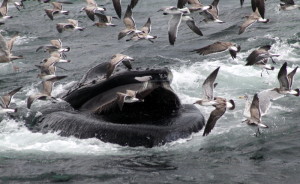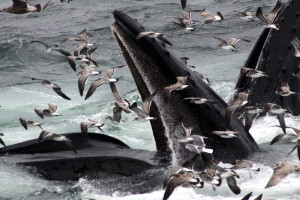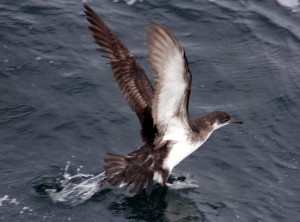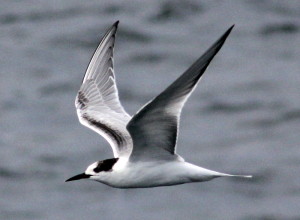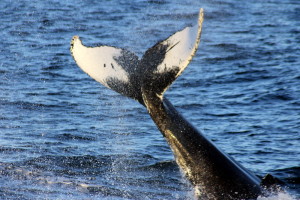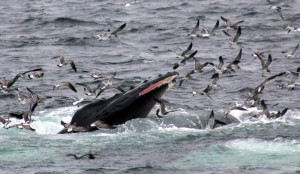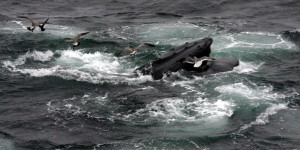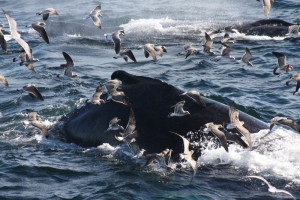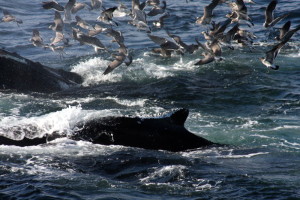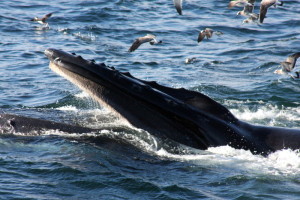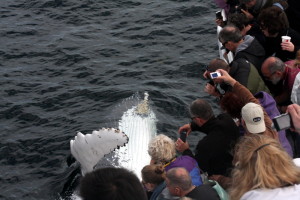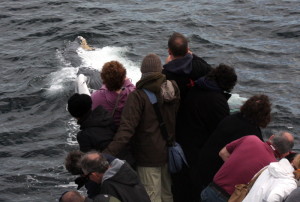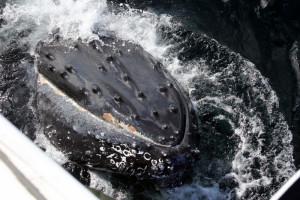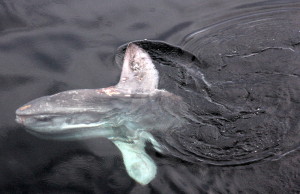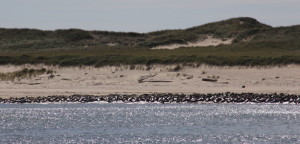September 26 to October 2
A stiff breeze and choppy seas didn’t stop us from heading out to Peaked Hill on September 26th, and we were certainly happy that we did. We witnessed a feeding bunch of humpbacks that grew to at least fifteen individuals throughout the day! These humpbacks were blowing huge nets of bubbles, sometimes collaboratively, in order to engulf huge mouthfuls of prey, which we assumed to be sand lance.
There has been a lot of discussion among scientists who study humpbacks who wonder about the energetic costs of this bubble and lunge feeding behavior, and it has long been assumed that the act of swimming forward with a wide open mouth, engulfing and subsequently swallowing food required coming to almost a complete halt. However, a recent study by Simon et al. suggest that humpback whales are able to time their fluke strokes during the lunge to maintain momentum during a lunge, preparing for their next feeding lunge before they’ve even finished filtering what’s already in their mouth!
The half dozen birders we had on board the mid-day trip were equally delighted by the huge diversity of seabirds we had flocking to the scene. Of particular note were the Manx shearwaters, who can be distinguished by other shearwater species in the area by their slightly smaller size and distinct black and white contrasting plumage.
The birders on board also pointed out two species of tern, the Roseate and the Forster’s. Terns can be particularly hard to identify by species, so we were very happy to have their assistance!
The calm ride through Cape Cod Bay on September 27th was no indication of how it would be once we rounded the point. Here, we found 3 – 6 foot seas, and a few large groups of humpbacks just north of Peaked Hill. Music, Aswan, Ventisca, Degree, Evolution, Sanchal and Zeppelin were in a feeding group, and we noticed that Ventisca and Zeppelin were taking turns rolling through the bubble nets.
Soon, Longboard joined the group along with a small unidentified individual. We also got a chance to see a few Minke whales, clearly attracted to the abundant food in the area. These smaller baleen whales criss-crossed the area. On the occasion that we looked up away from the feeding frenzy, we noticed that immature laughing gulls were gathering among the feeding whales, sometimes chasing terns that had caught sand lance pushed to the surface by the whales! The gannets were also enjoying the bounty, seemingly dropping from the sky in dramatic plunge dives.
Meanwhile, aboard the Dolphin IX, the rough seas were riling up the humpbacks such that we got to see a full range of active surface behaviors. Thumper, mother of a calf who was spotted right nearby, tail breached, sending a wall of spray all around her.
We also watched an unidentified humpback with distinctive black flippers rolling and slapping those pectoral fins. Interestingly, most of the humpbacks on this coast have white flippers, while most humpbacks in the Pacific have black flippers. It’s only about ten percent of our population that sports this unusual pigmentation.
When we headed back for home we were able to spot an additional type of marine mammal once the seas had calmed down. Peaked up over the crests of the waves was a grey seal, now spotted in increasing numbers up and down the Cape.
On September 28th we made our way out to Peaked Hill where we had good looks at six different humpback whales, including Longboard, Music, Degree, Manhattan and Lilium. Several time, one of them even breached!
Samara was a particularly easy whale to identify. This young whale has a distinctive dent right behind her blowholes, likely the result of a collision with a boat, which is sadly, not altogether uncommon for large whales in our region.
The excitement really picked up in the afternoon, where the number of whales increased to around 16, and the feeding began. The Dolphin IX witnessed feeding all around the boat.
Some of the whales were using clouds and nets of bubbles to corral their prey, while others used their tail to stun fish through a behavior known as kick feeding. This feeding style seems to be especially effective at concentrating sand lance, as this behavior is most frequently seen in areas where this is the dominant food source.
After smacking the water with a kick, this humpback would lunge through the school of fish on its side, one of its flukes just clearing the surface!
The feeding picked up again on September 29th, and once again, the spot to be was off Peaked Hill. This area off the northern edge of Provincetown, bordering on Truro is often a great spot to see whales because of the bathymetry of the area. Rather sloping gently downward, the ocean floor drops abruptly a few hundred feet from shore, creating a vertical edge against which nutrients and schools of fish, and by extension, whales, can aggregate.
Today, in spite of the nasty wind coming in from the north, we were able to watch Aswan, Music, Ventisca and Longboard bubble feeding.
We were also excited to see a humpback named Goalpost in the mix. The Provincetown Center for Coastal Studies disentangled this whale last week, and it looks like she is recovering nicely!
After cancelling our trips for bad weather on September 30, we ventured back out again on October 1st. It was still windy, but fortunately, the humpbacks were still feeding away. We saw some familiar tails, and also had a few surprises. Aswan, Music, and Ventisca had pretty much stayed put during the last few days and continued to chow down.
The big surprise came when Salt, the Dolphin Fleet’s favorite whale due to her yearly presence in Stellwagen Bank since 1975, popped up out of nowhere. She immediately broke up the group feeding dynamics, plowing right through the bubble cloud and most certainly taking some fish for herself.
Tagging studies have shown that sometimes humpbacks will lurk on the edge of bubble clouds, waiting for other whales to do all the work of aggregating the prey, and then swooping in to take it all for themselves. With all of her experience on the feeding grounds, we wondered if Salt was craftily hovering in the sidelines taking advantage of her younger con-specifics’ hard-earned sand lance!
As if that wasn’t exciting enough, we periodically caught fleeting glimpses of bluefish and bluefin tuna swimming by, clearly after the same big school of sand lance. With the four species of shearwaters, gannets, and terns hovering above, waiting to feast on the remnants of the whale and fish meals, it was almost as if we had a sand lance sandwich, and we marveled at the fact that this one species can sustain so many others in this ecosystem.
The winds dropped by October 2nd and we experienced a beautiful, calm day with silky smooth seas and a light southwest wind. We first went to Peaked Hill to where the whales had been gathering for the past few weeks. We saw two long-diving humpbacks who failed to raise their flukes on their dives, making it very difficult to get a positive identification.
Despite the excellent visibility, we couldn’t see any other whales in the area. We headed north, and then east, where we came upon two pairs. Reflection and Aswan were traveling to the southeast and were fluking, showing the unique and distinctive patterns on the undersides of their flukes.
Habenero and her calf were resting and when we approached, the calf came right up to the boat! As we were about the leave, the calf rolled over and lifted a flipper in the air, then backstroked along the port side of the boat, then right under the bow!
Meanwhile, the Dolphin IX was having a close boat approach of their own, this time from a humpback named Hazard, born to Roswell in 2007. This young whale stuck its head out of the water so close to the boat that we could see the large hair follicles dotting its head and the barnacles dotting its chin!
This boat also got a chance to see one of the more bizarre creatures to visit our water. The Mola mola or ocean sunfish drifts languidly along, feeding mostly on jellies and other small planktonic prey. In fact, it is considered plankton itself despite weighing several hundred pounds.
Our trip was completed as we cruised close to shore to get a look at the Grey Seal haul out on the north facing beach of Provincetown. These large seals will often come onto land to rest. The whale watch is an ideal spot to watch these seals, as approaching them on land is often disturbing and stressful to them.






